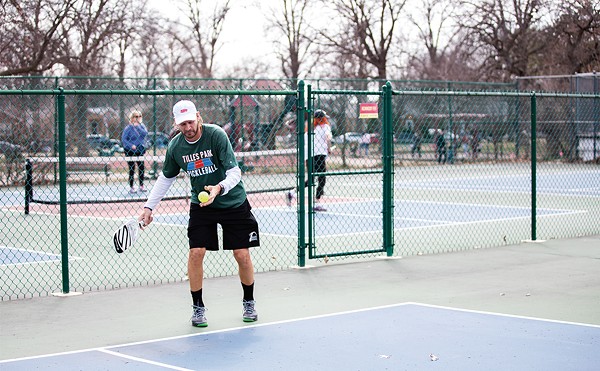Here's another surprise: Aspects of Being works. As a title, it aptly represents the theme of this show, which is neither totally ironic nor bloated with existential angst. Aspects of Being includes new work by Sue Eisler, Phillip E. Robinson, Arnold Nadler and Ling-Wen Tsai. Each artist in some way addresses human needs and desires, and how these can be dictated by social or physical circumstances beyond immediate human control. As heavy as that theme is, the artists manage to address it in a balanced and informed manner, often with a good measure of humor. This group of 19 pieces, mostly sculptural, is a survey of some of the best work being produced in the region right now.
Robinson's eight works in this show are, as usual, right on target, both formally and thematically. His works here deal, in oblique and humorous ways, with those slippery symbols of "upward mobility" and our notions of social and economic success. "Fastforward" is a small, truncated school bus, minus the wheels, cut in the shape of a loaf of white bread, whereas "Little Ease" looks like a 1950s-era toaster or waffle iron, also taking the shape of a bread slice. The pieces reference a vision of middle-class stability (white bread, education) that belongs to a different era yet remains as recognizable today as ever.
Robinson's works are acute observations on these social visions, which often hinge on actual social and racial inequity. In Robinson's "Torte" and "Fro-Cake," symbols of blackness and whiteness literally collide. Both look like slabs of layer cake -- the kind you would see on the cover of a Betty Crocker cookbook. But Robinson has substituted curly black Afro hair where the gooey pink icing ought to be.
The suburban house is another of Robinson's favorite symbols. Robinson reduces the house -- that icon of stability and the American dream -- to its barest iconic form (two walls and a pitched roof, no windows or doors). He attaches it to the wall so that it hovers, cantilevered and precarious, in midair; or he fashions the house into the shape of a mine, ready to explode at the slightest disturbance. Thus Robinson gives visual form to all the tension that percolates below the veneer of suburban respectability.
Nadler's sculptural work makes comments of comparable profundity, but with an entirely different sensibility. Where Robinson's pieces are wrought with a hard edge and tongue firmly planted in cheek, Nadler's are heart-wrenchingly beautiful and yet painful forms. On first glance, they appear to be mere skeins of curving and knotted metal, frozen in graceful arabesques. On closer inspection, details take shape: Lines become crutches; another passage takes the form of a geriatric walker; curves terminate in standard-issue rubber stoppers. These works reference the equipment of the disabled, the structures designed to compensate for physical deficiencies.
Formally, Nadler's works draw on the lessons of such sculptors as Tony Cragg and Richard Deacon. But they possess an added layer of oddly unsentimental pathos that makes them completely unique and effective. Nadler has received far too little exposure in St. Louis. He is an artist to watch.
A more recent piece, "Surmount," signals another direction Nadler's work is taking. It's a Leonardo da Vinci-esque flying machine that looks as if it might have carried urgent news from another world. The operator of this machine, however, has evidently crashed the craft on entry. What remains is only twisted metal and malformed wings. Again, Nadler artfully addresses the frustration of physical and mental limitations and the dream of making something whole again.
Eisler's works on paper, suspended in Plexiglas stands, are another kind of reflection on human vulnerability. Eisler's works consist of paper templates used in the manufacture of shoes. She paints these shapes, layering them one over the other and sandwiching them in the Plexi frames. The resulting forms are slight but lovely abstractions that also bear witness to the processes of physical labor and the often-intimate relations to materials that labor requires.
The final artist in this show, Ling-Wen Tsai, is represented by "A Place," an installation of square columns that run from floor to ceiling. On first glance they could be mistaken for a Robert Morris-style minimalist sculptural environment. But Ling-Wen's approach actually brings her closer to the work of post-minimalists like Eva Hesse. Her columns are formed by individual hanging pieces of fiberglass screen. They offer the illusion of solidity and permanence; in actuality, they are fragile and contingent -- much like human beings.
Exposure III: Aspects of Being gains its strength not just from the individual artists. Credit is owed for its success equally to the curator, Terry Suhre. Suhre's fascinating theme and the pieces he has selected for this exhibition hold up to close scrutiny and remain strong and engaging.





